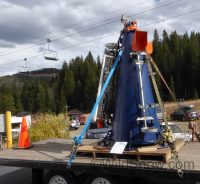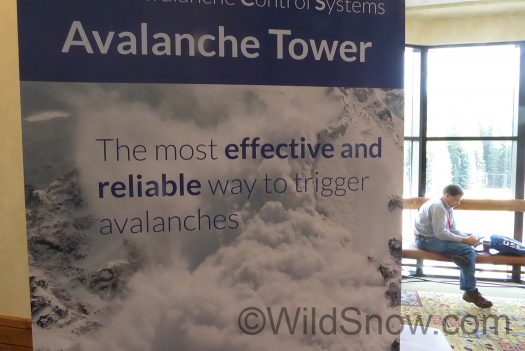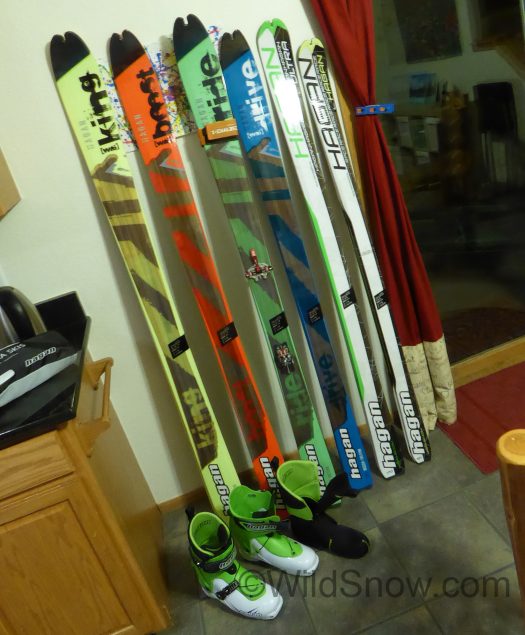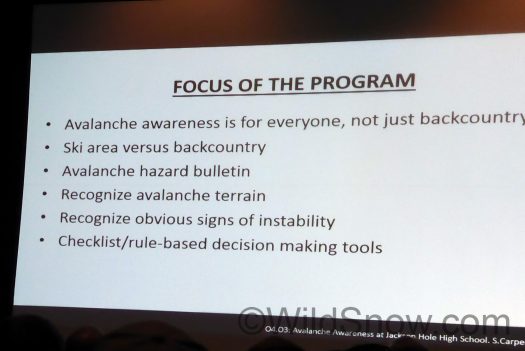
The kind of stuff you see at ISSW. Humans, ever innovative. This is the Daisy Bell Remote Avalanche Control fly it under your helicopter, set on the snow, explode a gas mixture inside the open cone, then move on to the next trigger zone. Said to be ‘profitable — for rapid return on investment!’ Click to enlarge.
ISSW, enough graphs and math formulas to keep twenty PHDs happy for forty years. Mixed in, you find a few gems for the common ski touring man and woman. Honestly, to be fair, this avalanche safety conference is subtitled “merging of theory and practice,” so you do get a bolus of take-home no matter what your level of snow geekology happens to be.
The industry networking is fine as well, with folks such as BCA, Mammut, Scarpa and Arcteryx on-site, along with probably 99% of the best people in the field — both on the practice side and the lab side.

Did your partner in the BC ever ask you, ‘Hey, in your opinion what is the most effective and reliable way to trigger avalanches?’
Yesterday I cherry picked a few presentations I figured had a good emphasis on education, and was not disappointed.
First off, remember when the New York Times a few years ago did that online interactive report on the Tunnel Creek avalanche in Washington? They won a few awards for that thing — along with making a stately contribution to avalanche education that’s still entirely relevant.
In 2013, a group near Terrace, British Columbia, got ‘lanched in a class “3 & 1/2” slide that took their whole party out and buried three out of four. The three buried individuals probably would have died if it hadn’t been for a nearby party of experienced locals who did a textbook rescue. Result, a multiple burial — amazingly with no fatalities.
At the time, a film company was in the area doing some work. As spec, the filmers did extensive interviews with every participant in the event — an hour or more of talking with each individual. They made a short flick that’s excellent, check it here.
Since then, in what sounds like a massive and challenging publishing project, Avalanche Canada has used that footage and built a fully interactive website around it: Rescue at Cherry Bowl – Buried Alive, that — UPDATE November 2016, now launched HERE
Mary showed some snips from the new site, including videos. Impressive. As she said, the interviews are incredibly honest takes on what it’s really like to be involved in a life changing event due to a force of nature.
What stood out for me is Mary mentioning that the guys who performed the rescue credited their extensive and recent training with the outcome. A lesson for all of us. When was the last time you really truly trained in an avalanche rescue simulation?
What is more, Mary explained that another reason for the “exceptional” rescue that “defied all odds” as the responder’s being a “tight” group who not only trained together, but had a tradition of communication within their group that led to quick decision making and response.
What kind of groups do you ski tour with in avalanche terrain? Casual groups with random additions at the last minute, along with a definite “follow the leaders” dynamic? Or do you have a specific crew that rarely changes, who are all comfortable with honestly speaking their opinions and feelings at the slightest provocation? While no perfect formula exists (it’s fun to meet new partners), I’d remind anyone to think about all this. If you’re concerned about your personal safety, a tight group with strong communication is always better.
Next up, Sarah Carpenter (one of our esteemed WildSnow guest bloggers, with American Avalanche Institute) and Trevor Deaton live in Jackson, Wyoming. The pair gave an inspiring presentation about what I’d say is extremely important avalanche safety program they operate at Jackson public high school. Goal is to get 100% of program participants to learn what sounds like the knowledge base of Avalanche 1, along with inculcating habits such as checking the avalanche forecast before going backcountry.
Apparently,something like 75% of high school students in Jackson do winter backcountry recreation in avalanche terrain, ranging from snowmobiling to building kickers up on Teton Pass. What is more, 58% of Jackson high school seniors know of someone caught or killed in an avalanche! Thus, the need is there.
Surveys presented by Sarah indicate the program works, but anything can be improved.
Enter Emory Rheam, a 16-year-old from Jackson who did her own incredibly impressive study and presentation on how an avalanche safety program could be tailored to better fit teenagers.
Emily took us through the theory of brain science that says youngsters tend to have trouble making good decisions about risk, and the brain doesn’t complete maturing for good decision making until as late as 25 years of age. Then she brought in the bugbear of media influence, with a mention of how many TGR films show skiers charging through avalanches — not exactly the best imagery for the 18-year-old mind dealing with dangerous terrain.
Peer pressure and yes the distraction of smart phones where mentioned — though concrete solutions for those somewhat “teenage” problems appear to be challenging. More than anything, Emily caught my attention with her mentions of how exactly do you get kids to utilize a decision making process? She said mentors are powerful, and clear-cut methodology such as the ALP TRUTHS check list is helpful for young brains.
I checked out a few rocket science presentations as well. Trying to blog about them would make me look like a fool so I’ll just say that the combination of GPS, PHD statistics professors and guide services needing to refine their safety procedures is a heady combination.
Commenters, what do you think about helping teenagers make good decisions about their avalanche terrain recreation? Clearly, just saying no isn’t going to work. Snow play is too much fun.

Bonus shot, Hagan sighting in Breckenridge, Colorado.
WildSnow.com publisher emeritus and founder Lou (Louis Dawson) has a 50+ years career in climbing, backcountry skiing and ski mountaineering. He was the first person in history to ski down all 54 Colorado 14,000-foot peaks, has authored numerous books about about backcountry skiing, and has skied from the summit of Denali in Alaska, North America’s highest mountain.

